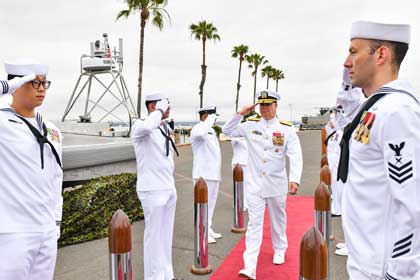
NAVAL BASE CORONADO (May 17, 2024) - Commander, Naval Surface Force, U.S. Pacific Fleet Vice Adm. Brendan McLane is rung in upon his arrival to the establishment ceremony for Unmanned Surface Vessel Squadron 3 (USVRON 3) on Naval Amphibious Base Coronado May 17, 2024. The squadron is comprised of unmanned Global Autonomous Reconnaissance Crafts (GARCs). The 16-foot GARCs built by Maritime Applied Physics Corporation enable research, testing, and operations that will allow integration throughout the surface, expeditionary, and joint maritime forces. U.S. Navy photo by MC1 Claire M. DuBois.
SURFOR establishes Unmanned Surface Vessel Squadron (USVRON) Three
by Karli Yeager, Commander, Naval Surface Force, U.S. Pacific Fleet
SAN DIEGO – Commander, Naval Surface Force, U.S. Pacific Fleet (CNSP) established Unmanned Surface Vessel Squadron (USVRON) Three at Naval Amphibious Base Coronado during a ceremony, May 17.
USVRON Three will oversee a fleet of small, unmanned surface vessels (sUSV) known as Global Autonomous Reconnaissance Craft (GARC).
During the ceremony, Capt. Derek Rader assumed command of the newly established USVRON Three.
“Our Sailors are the essential key for integration of unmanned surface vessels in the Navy and joint construct,” said Rader. “This will be accomplished through experimentation with the fleet testing and doctrine drafted by operators you see today, who embody and execute the warfighting that we need to achieve to enable the full potential of unmanned systems.”
USVs, including the GARCs, will provide additional warfighting capability and capacity to augment the Navy’s traditional combatant force, providing commanders with a greater range of capabilities and employment options to increase the Fleet’s tactical and strategic advantages. The goal for USVs is to provide the fleet with operations in conjunction with carrier strike groups, surface action groups, or even independently.
Manufactured by the Maritime Applied Physics Corporation, GARCs are 16-foot USVs that enable research, testing, and operations that will allow integration throughout the surface, expeditionary, and joint maritime forces.
Commander, Naval Surface Forces U.S. Pacific Fleet Vice Adm. Brendan McLane delivered the keynote speech at the ceremony.
“With challenging obstacles to overcome, we have put the right team in place at USVRON Three, and I believe we have done just that,” McLane said. “The Navy is placing unmanned systems in the hands of 400 of our most talented warfighters to help integrate, scale, experiment, and employ these systems.”
USVRON Three will also incorporate the newest rating, the robotics warfare (RW) specialist into their teams. The rating was announced in February by the Chief of Naval Operations (CNO). They will enable Robotic Autonomous System (RAS) operations and maintenance at the tactical edge and be the subject matter experts for computer vision, mission autonomy, navigation autonomy, data systems, artificial intelligence, and machine learning on the RAS platforms.
USVRON Three will report to Surface Development Group (SURFDEVGRU) One, under the direction of Cdre. Shea Thompson.
“There are currently no boundaries, and we have an incredible opportunity to determine what right looks like within our sphere of influence,” said Thompson. “And the SURFDEVGRU One and USVRON Three teams are manned by like-minded surface warriors who are making considerable strides in validating small USV capability while laying out a clear path to achieving full operational capability by a timeframe that matters.”
The mission of USVRON Three is to deliver the most formidable, unmanned platforms in the maritime domain. The squadron will be a cornerstone in building the foundational knowledge required to operate and maintain sUSV and will spearhead the development of TTPs for sUSV operations and sustainment. USVRON 3’s motto is “Victory Through Ferocity.”
SURFDEVGRU 1 is responsible for the maintenance, training, and manning oversight for unmanned surface vessels (USV), Zumwalt-class guided missile destroyers, and the future USS Lyndon B. Johnson (DDG 1002).
The mission of CNSP is to man, train, and equip the Surface Force to provide fleet commanders with credible naval power to control the sea and project power ashore.
Military News | Navy News | USVRON 3 established at SURFOR


